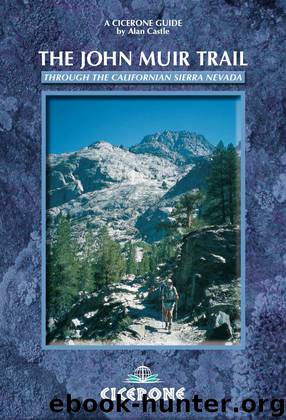The John Muir Trail by Alan Castle

Author:Alan Castle
Language: eng
Format: epub
ISBN: 978-1-84965-348-0
Publisher: Cicerone Press
Published: 2010-03-22T04:00:00+00:00
BIRDS OF THE JOHN MUIR TRAIL
As the John Muir Trail winds up and down along the Sierra Nevada, backpackers walk daily through varied terrain and habitats of differing vegetation zones. Each day, therefore, many different kinds of birds can seen, but walking with head down and a heavy backpack does not make for ideal bird watching. When you stop for breath, a rest, a snack, or at camp look up at the sky and the trees, for you may spot any of a number of species.
Books and checklists of birds are available at the visitor centres and shops at Yosemite and Whitney Portal. Yosemite’s list gives 154 species that may be seen along the way, and Whitney Portal’s has 241. Long lists are difficult to use en route, but one of the Peterson Field Guides, California and Pacific Northwest Forests, is compact and illustrates and lists birds by different habitats. Knowing which birds are most likely at any place makes identification easier. A summary of birds commonly seen in particular habitats is given below (although a number of species frequent more than one habitat).
Birds of open areas: The trailhead campsites and areas around outdoor eating places often have groups of Brewer’s Blackbirds running around. Towards dusk the flocks join into larger groups flying towards their roosting sites. Flights are dramatic silhouetted against sunset. Large birds such as Common Ravens, Golden Eagles, Red-tailed Hawks and Turkey Vultures are easily spotted calling and wheeling at times to great heights.
Birds of the forest: Steller’s Jays are noisy black-and-blue birds with large crests. They approach close, attracted by food scraps around camp grounds. Blue grouse, about the size of a domestic fowl, inhabit forests to all levels, as does the Mountain Chickadee, a tit with a greyish back, a black cap and throat. White-crowned Sparrows are recognisable from the many other birds that look like sparrows by their pink bills and conspicuous black-and-white striped heads. Two black-and-white woodpeckers, the Hairy Woodpecker and Williamson’s Sapsucker, the latter distinguished by its yellow belly and red throat, forage round tree trunks. Other woodpecker species frequent forests at different levels, and in places, such as Reds Meadow, the dead wood left after forest fires provides excellent nesting sites as well as wood-burrowing insects for food.
Rivers, lakes and adjacent forest: Several specialised birds frequent this habitat, but many of the forest birds may be found here too. Deciduous trees such as California Sycamores, alders, ash, poplars and willows grow along the riverbanks. A rich under-storey of berry-bearing shrubs grows with them and provides cover for colourful Belted Kingfishers as they perch quietly on branches overlooking water. In flight they give a loud rattling chatter. The diversion across Lake Edison to Vermilion resort by the ferry is an opportunity to sit back and watch ospreys fishing. The rare California Gulls, which nest by a few high mountain lakes, disperse after breeding and stop over at larger lower lakes en route to the coast.
Mid-elevation pine forest: This is a zone of mixed conifers, with Ponderosa and Jeffrey’s pine dominant.
Download
This site does not store any files on its server. We only index and link to content provided by other sites. Please contact the content providers to delete copyright contents if any and email us, we'll remove relevant links or contents immediately.
In a Sunburned Country by Bill Bryson(3376)
Annapurna by Maurice Herzog(3302)
How to Read Nature by Tristan Gooley(3086)
Dangerous Girls by Haas Abigail(2843)
SAS Survival Handbook by John 'Lofty' Wiseman(2583)
The Lost Art of Reading Nature's Signs by Tristan Gooley(2550)
In the Woods by Tana French(2422)
The Stranger in the Woods by Michael Finkel(2330)
Food and Water in an Emergency by Food & Water In An Emergency(2273)
Guns, Germs and Steel by Diamond Jared(2206)
Wild: From Lost to Found on the Pacific Crest Trail by Cheryl Strayed(2144)
Everest the Cruel Way by Joe Tasker(2135)
Backpacker the Complete Guide to Backpacking by Backpacker Magazine(2111)
Trail Magic by Trevelyan Quest Edwards & Hazel Edwards(2064)
Ultimate Navigation Manual by Lyle Brotherton(2055)
Sea Survival Handbook by Keith Colwell(2045)
Welcome to the Goddamn Ice Cube by Blair Braverman(1888)
Birds of the Pacific Northwest by Shewey John; Blount Tim;(1876)
The Last Flight by Julie Clark(1839)
